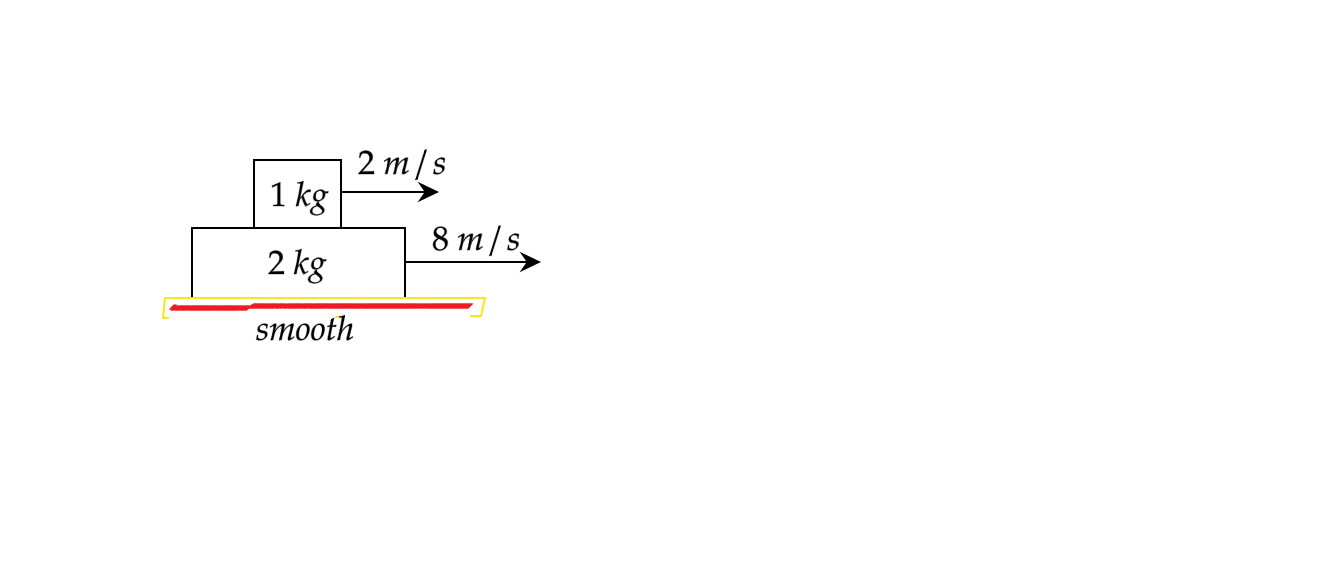
Coefficient of friction between two blocks shown in the figure is

Answer
146.7k+ views
1 likes
Hint: The relative velocity between the blocks will stop when both the blocks have the same velocity. So if we find the velocity at a certain instant after the start of motion between the blocks and equate them, we can get the time when the relative motion stops. To find the velocity at a certain instant, we need to find the accelerations of the two blocks and hence we must start with the forces acting on the block.
Formula Used:
Complete step by step solution:
The floor of the setup is smooth, so no frictional force acts on the
From Newton’s law of action and reaction, the reaction of the friction force acting on the
When the relative motion between the two blocks stops, they move together as one single body. This is similar to the inelastic collision of bodies when they stick together after the collision.
So we can apply momentum conservation before and after the relative motion between the blocks stops, which states the sum of the momentum of the blocks before the relative motion stops will be equal to the momentum of the body after the relative motion stops.
Mathematically, we can express it as
Solving the above equation, we get
Friction force acting one the
Hence the friction force will be
Substituting the values, we get
Now, the only force acting on the two blocks will be this friction force of
The friction force tends to oppose the motion of the body and hence, for the
Acceleration of the
Hence,
Similarly, acceleration of the
Now, we have to find the instant when the relative motion stops. To do that, we simply have to apply the first equation of motion to any of the blocks, that is
Applying this equation to the
Hence the relative motion stops in
To find the displacement of the blocks, we need to apply the second equation of motion to both the blocks, that is
For the
Similarly, for the
Hence the displacements of the
Note: Students often make the mistake of applying the friction at every interface because the value of the coefficient of friction is given. It must be noted that friction does not act on smooth surfaces, hence there is no friction acting between the floor and the
Formula Used:
Complete step by step solution:
The floor of the setup is smooth, so no frictional force acts on the
From Newton’s law of action and reaction, the reaction of the friction force acting on the
When the relative motion between the two blocks stops, they move together as one single body. This is similar to the inelastic collision of bodies when they stick together after the collision.
So we can apply momentum conservation before and after the relative motion between the blocks stops, which states the sum of the momentum of the blocks before the relative motion stops will be equal to the momentum of the body after the relative motion stops.
Mathematically, we can express it as
Solving the above equation, we get
Friction force acting one the
Hence the friction force will be
Substituting the values, we get
Now, the only force acting on the two blocks will be this friction force of
The friction force tends to oppose the motion of the body and hence, for the
Acceleration of the
Hence,
Similarly, acceleration of the
Now, we have to find the instant when the relative motion stops. To do that, we simply have to apply the first equation of motion to any of the blocks, that is
Applying this equation to the
Hence the relative motion stops in
To find the displacement of the blocks, we need to apply the second equation of motion to both the blocks, that is
For the
Similarly, for the
Hence the displacements of the
Note: Students often make the mistake of applying the friction at every interface because the value of the coefficient of friction is given. It must be noted that friction does not act on smooth surfaces, hence there is no friction acting between the floor and the
Recently Updated Pages
How to find Oxidation Number - Important Concepts for JEE

How Electromagnetic Waves are Formed - Important Concepts for JEE

Electrical Resistance - Important Concepts and Tips for JEE

Average Atomic Mass - Important Concepts and Tips for JEE

Chemical Equation - Important Concepts and Tips for JEE

Concept of CP and CV of Gas - Important Concepts and Tips for JEE

Trending doubts
JEE Main 2025 Session 2: Application Form (Out), Exam Dates (Released), Eligibility, & More

JEE Main Exam Marking Scheme: Detailed Breakdown of Marks and Negative Marking

JEE Main 2025: Derivation of Equation of Trajectory in Physics

Electric Field Due to Uniformly Charged Ring for JEE Main 2025 - Formula and Derivation

JEE Main Participating Colleges 2024 - A Complete List of Top Colleges

Degree of Dissociation and Its Formula With Solved Example for JEE

Other Pages
JEE Advanced Marks vs Ranks 2025: Understanding Category-wise Qualifying Marks and Previous Year Cut-offs

JEE Advanced 2025: Dates, Registration, Syllabus, Eligibility Criteria and More

Units and Measurements Class 11 Notes: CBSE Physics Chapter 1

NCERT Solutions for Class 11 Physics Chapter 1 Units and Measurements

Motion in a Straight Line Class 11 Notes: CBSE Physics Chapter 2

JEE Advanced Weightage 2025 Chapter-Wise for Physics, Maths and Chemistry




